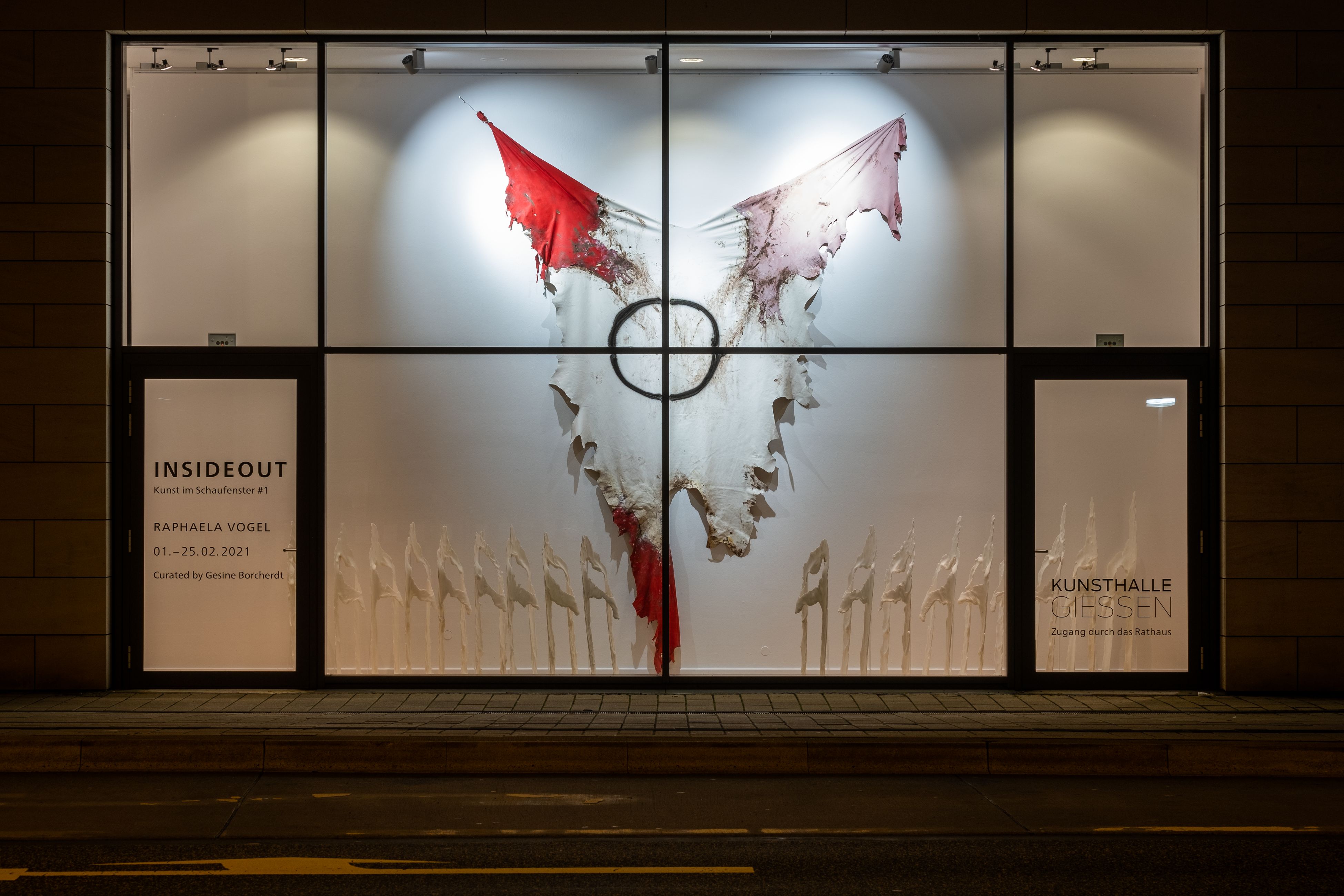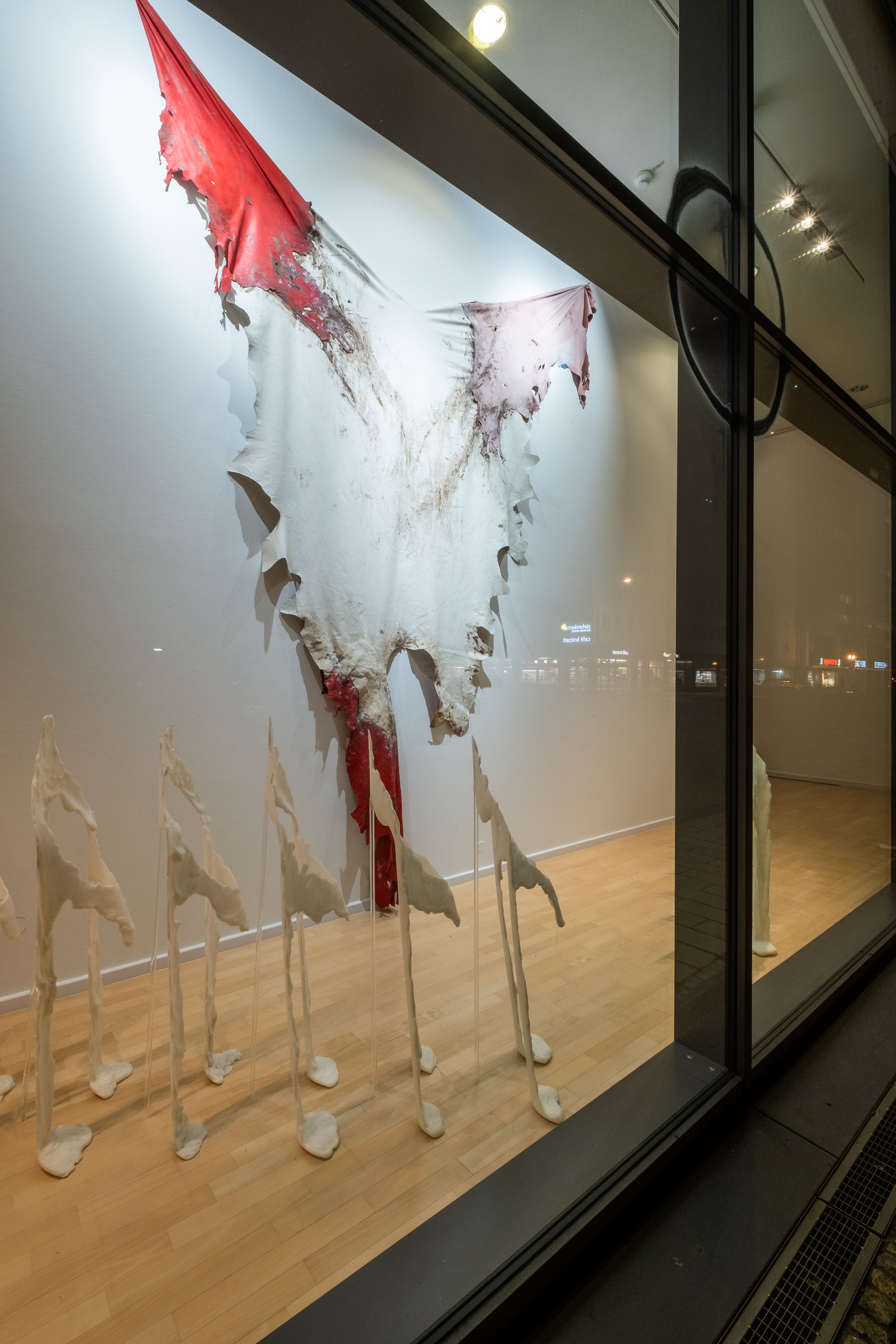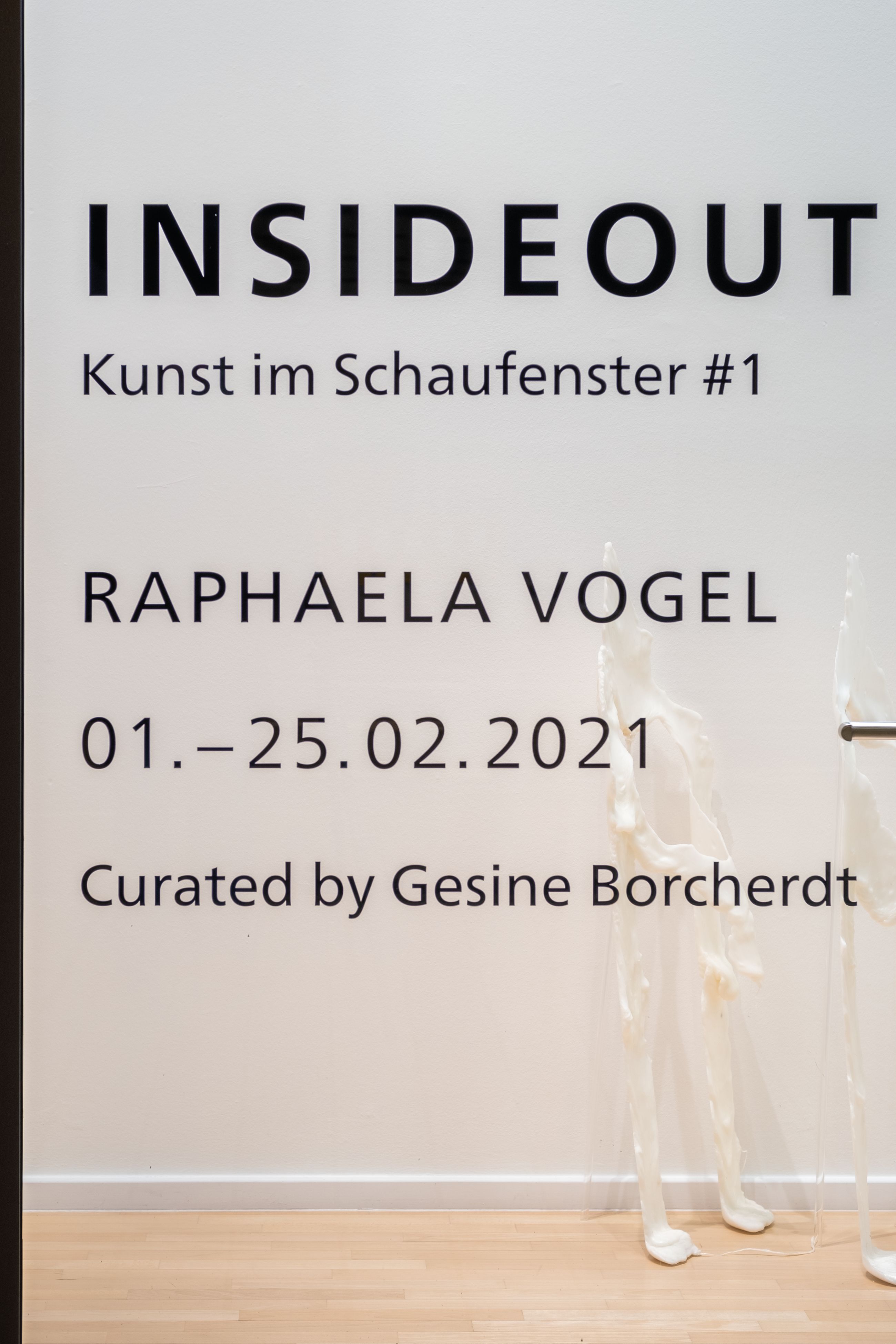INSIDEOUT
Kunst im Schaufenster
Unter dem Titel INSIDEOUT bespielen die Kuratorinnen Gesine Borcherdt und Dr. Julia Wirxel nacheinander ab Februar bis April das Schaufenster der Kunsthalle Gießen mit monatlich wechselnden künstlerischen Positionen. Mit diesem neuen Format antwortet die Kunsthalle auf die aktuellen, pandemiebedingten Schließungen von Kulturinstitutionen. INSIDEOUT trägt die Kunst vom geschlossenen Innenraum in den Außenraum und ermöglicht so den Besucher*innen, weiterhin aktuelle Kunst zu sehen.
INSIDEOUT is the new exhibition series, where the curators Gesine Borcherdt and Dr. Julia Wirxel successively occupy from February to April the display window of the Kunsthalle Gießen with monthly changing artistic positions. With this new format, the Kunsthalle is responding to the current, pandemic-related closings of cultural institutions. INSIDEOUT carries the art from the closed interior to the exterior, thus enabling visitors to continue to see current art.
1.–25. Februar | February 2021
#1 Raphaela Vogel
kuratiert von / curated by Gesine Borcherdt
Weißes Silikon, wie schockgefrorene Körpersäfte. Aufgespannte Tierfelle, als wären sie gebrochene Flügel. Die Installationen von Raphaela Vogel (geboren 1988 in Nürnberg, lebt und arbeitet in Berlin) appellieren an alle Sinne. Sie sind forsch und fordernd, verträumt und intensiv, humorvoll und melancholisch, widersprüchlich und provokant. Viele beziehen sich auf Tiere. Aber auch Marsias und Arachne sowie Musikcollagen aus Klavierkompositionen, Drohnensounds und schrillen Schlagern kommen immer wieder vor, ebenso wie die Künstlerin selbst, wenn sie in ihren Videos auftaucht. Vogels Arbeiten bilden Kreisläufe: intuitiv, verzerrt, unwirklich und genau deshalb in sich stimmig. Allgegenwärtig ist das innere Druckgefühl einer Künstlerin, deren Werk wie in einem hypnotischen Bewusstseinsstrom alles mit sich reißt – und die der Gegenwartskunst eine ganz neue feministische Bildsprache verleiht.
Für INSIDEOUT im Schaufenster der Kunsthalle Gießen stellt Raphaela Vogel eine Reihe von „Uris“ auf: Weiße Silikonabgüsse von freistehenden Urinalen, wie sie an Stränden oder auf Festivals benutzt werden. Die seltsamen, skelettartigen Formen wirken, als würden sie selbst gerade brav anstehen, bis sie an der Reihe sind. Trotz ihrer expressiven Erscheinung sind sie beinahe identisch und weisen keine signifikant individuelle Handschrift auf – ihre Figuren entstehen allein durch das Material, das an den Pissoirs herabgelaufen ist.
Über ihnen ist an der Wand eine riesige bemalte Collage aus Elch- und Pferdehäuten angebracht. „Der Zahn“ erinnert in seiner Zuspitzung an eine Zahnwurzel, doch vor allem greift er eine Form auf, die bei Raphaela Vogel immer wieder auftaucht: das Dreieck. Als stärkster Kontrast zum virilen Rechteck, wie es die meisten Architekturen bestimmt, findet sich in ihm eine Metapher, die bei INSIDEOUT besonders ins Auge springt: Wie ein Schamdreieck dominiert es die Wand als riesiges weibliches Genital, das zugleich abstrakte Malerei ist. Vogel spielt damit auf eine Disziplin an, die besonders für männliche Kunstgeschichte steht. Schon früh hat die Künstlerin Leder bemalt und so eine neue Freiheit von der vorbelasteten Leinwand erlangt, zumal Tierhäute bereits eine Bedeutung transportieren.
Es ist diese obskure Körperlichkeit, die Raphaela Vogels Werk auszeichnet. Kombiniert mit neuesten Materialien und Techniken, denen jedoch stets etwas Brüchiges anhaftet, entstehen Erzählungen in einer ganz eigenen, dystopischen Bildsprache – voller Scharfsinn, Symbolkraft und Humor, die weit über den Zeitgeist unserer digitalen Epoche hinausgeht.
White silicone that looks like flash-frozen bodily fluids. Animal skins stretched on the wall that look like splayed wings or pubic triangles: Raphaela Vogel's (born 1988 in Nuremberg, lives and works in Berlin) installations appeal to all the senses. They are brash and demanding, dreamy and intense, humorous and melancholic, contradictory and provocative. Many of the works relate to animals – the artist grew up in the countryside – toys, myths and pop music recur, as does the artist herself. With her hypnotic-archaic work, she is one of the most important young German artists who has lent art a whole new feminist visual language.
For INSIDEOUT in the display window of the Kunsthalle Gießen, Raphaela Vogel will erect a series of ‘Uris’: white silicone casts of free-standing urinals like the kind used on beaches or at festivals. The curious, skeleton-like forms look as if they were just dutifully standing in line awaiting their turn. Despite their expressive appearance, they are almost identical and display no significantly individual signature – their figures were formed solely from material that Vogel let flow down the side of the urinals.
There is a huge painted collage of moose and horse skins on the wall above them. ‘Der Zahn’, in its pointed form, is reminiscent of the root of a tooth, but above all it adopts a form that appears again and again in Raphaela Vogel's work: the triangle. Contrasting most strongly with the virile rectangle that dominates most architecture, it contains a metaphor that especially catches the eye in INSIDEOUT: Like a pubic triangle, it dominates the wall as a giant female genital that is at the same time an abstract painting. Thus Vogel alludes to a discipline that is particularly representative of masculine art history. The artist painted on leather from early on, gaining a new freedom from the preloaded canvas, all the more so as animal skins already carried meaning.
Raphaela Vogel's work is distinguished by this obscure physicality. Combined with the latest materials and techniques, which nevertheless always retain something fragile, narratives emerge in a very unique, dystopian visual language – full of astuteness, symbolic power and humour that extends far beyond the zeitgeist of our digital era.
Raphaela Vogel lebt und arbeitet in Berlin. Sie studierte an der Kunstakademie Nürnberg und an der Städelschule in Frankfurt. Ihre letzten Einzelausstellungen fanden u.a. im Neuen Museum Nürnberg (2020), im Kunsthaus Bregenz (2019), im Haus der Kunst München (2020), in der Berlinischen Galerie (2018) und in der Kunsthalle Basel (2018) statt. Zudem nahm sie u.a. an den Gruppenausstellungen DREAM BABY DREAM im Haus Mödrath, Kerpen (2020), Mythologies – The Beginning and End of Civilizations in Aarhus (2020), Game of Drones im Zeppelin Museum Friedrichshafen (2019) und Jeunes Artistes en Europe in der Fondation Cartier in Paris (2019) teil.
Raphaela Vogel lives and works in Berlin. She studied at the Nuremberg Art Academy and at the Städelschule in Frankfurt. Her most recent solo exhibitions were held, among others, at the Neues Museum Nürnberg (2020), Kunsthaus Bregenz (2019), Haus der Kunst Munich (2020), Berlinische Galerie (2018) and Kunsthalle Basel (2018). She has also participated in the group exhibitions DREAM BABY DREAM at Haus Mödrath, Kerpen (2020), Mythologies – The Beginning and End of Civilizations in Aarhus (2020), Game of Drones at the Zeppelin Museum Friedrichshafen (2019) and Jeunes Artistes en Europe at the Fondation Cartier in Paris (2019), among others.
Gesine Borcherdt ist Kunstjournalistin und Kuratorin und lebt in Berlin. Sie ist Autorin bei der Welt, Welt am Sonntag, BLAU International und AD Germany und war leitende Redakteurin des Kunstmagazins BLAU. Von 2014 bis 2019 war sie als Kuratorin des Kunstraums Capri in Düsseldorf tätig. 2020 kuratierte sie die Ausstellung DREAM BABY DREAM im Haus Mödrath in Kerpen. Derzeit arbeitet sie an einem Interviewbuch mit Valie Export.
Gesine Borcherdt is an art journalist and curator living in Berlin. She is a writer for Welt, Welt am Sonntag, BLAU International and AD Germany and was managing editor of the art magazine BLAU. She was a curator at the Capri art space in Düsseldorf from 2014–2019. In 2020, she curated the exhibition DREAM BABY DREAM at Haus Mödrath in Kerpen. She is currently working on an interview book with Valie Export.
Text: Gesine Borcherdt



